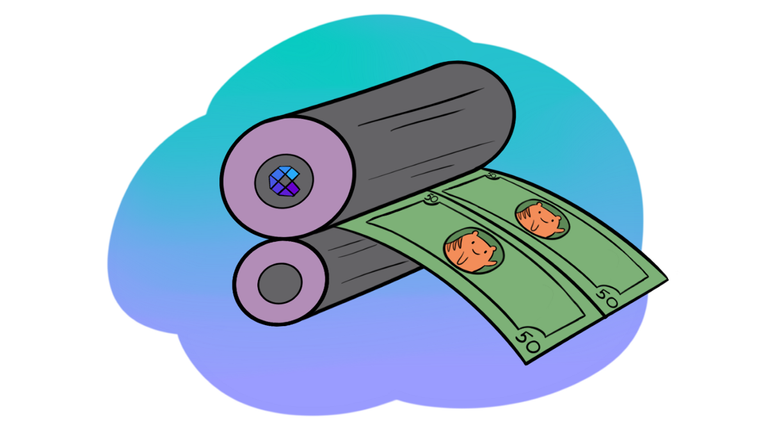Crypto’s Centralized Counterpart

The digital asset space has witnessed large strides in innovation over the last few years following the introduction of new forms of storing and transferring value - namely cryptocurrencies. In order to truly understand the value of cryptocurrency and other digital assets in this space, you must first be familiar with fiat currency and its own limitations when it comes to its naturally centralized system. Let’s go over the role of fiat currency in the emerging digital asset space and why it differs from cryptocurrency.
This is not financial investment advice.
This article will touch on key aspects of fiat currency and its relationship with cryptocurrency.
In this article
- What Is Fiat?
- History of Fiat
- Fiat Explained
- Advantages & Disadvantages
- Fiat Vs. Crypto
- Conclusion
What Is Fiat?
You’ve probably heard of “fiat” or “fiat currency” a number of times before but might not be completely sure of what it actually means. Put simply, fiat or fiat money is currency that a government has declared to be legal tender, but is not backed by a physical commodity. The key phrase to remember here is that it’s not backed by a physical commodity, meaning that all of its value is determined by a variety of factors outside of a physical commodity including supply and demand, economic performance, and national credit.
The only reason that fiat money has value is because the government maintains that value, using its centralized powers as tools to bolster or slow down the economy when appropriate. As opposed to gold, silver, or any other commodity-backed currency, fiat is an alternative which provides much more stability and is intrinsically valueless. Most countries use paper-based fiat and maintain its value by protecting against fraud, counterfeiting, and money supply problems.
Fiat money is currency that a government has declared to be legal tender, but is not backed by a physical commodity. All of its value is determined by a variety of factors outside of a physical commodity including supply and demand, economic performance, and national credit.
History of Fiat

Although the idea of fiat may seem like an age-old system, it actually hasn't been around for too long. Historically, most currencies were based on physical commodities such as gold or silver, but fiat money was first introduced by China ages ago and has since become the most popular way to issue legal tender. In 1971, U.S. President Richard Nixon set the scene for a successful fiat currency by enacting a law that stopped any and all conversion of the U.S. Dollar into gold. Since then, most countries have adopted fiat money and issue paper-backed money which is put into circulation across the world.
Remember, fiat money is intrinsically valueless and used solely as a means of payment. As such, governments would historically mint coins out of gold or silver to give the currency actual value. Paper money was first introduced in the 18th century when several American colonies, France, and many other nations began to issue bills of credit which were used to make payments. Once too many bills began to enter circulation, fear of inflation halted any further printing of paper-backed bills and allowed for the emergence of fiat money instead to protect the value of gold and silver. As fiat money cemented its place in the global economy over the subsequent years, an increasing number of nations across the world have since issued their own national currency.
Fiat money was first introduced by China ages ago and has since become the most popular way to issue legal tender. As fiat money cemented its place in the global economy, an increasing number of nations across the world have since issued their own national currency.
Fiat Explained

When you take a closer look at the big picture when it comes to fiat money, you’ll quickly realize that its lack of intrinsic value could pose a problem. Because it’s not linked to any physical reserves of commodities, fiat money runs the risk of becoming completely worthless if hyperinflation was to occur. Take Venezuela and its recent hyperinflation crisis for example.
Hyperinflation this past year has plagued the Venezuelan economy in multiple ways. The International Monetary Fund (IMF) has predicted that inflation can very well pass one million percent in Venezuela, shedding light on the potential threat of fiat money. As more and more people lose faith in the ability of the national government to regulate the fiat money value, hyperinflation ensues and causes businesses to charge more in order to keep up. If people lose faith in a nation's paper currency, the money will no longer hold any value. This differs from gold, which has been used in jewelry and decoration and has many modern economic uses including its use in the manufacture of electronic devices, computers, and aerospace vehicles.
Another way to analyze how fiat money works is to think about debt. When someone is in debt, they have no other choice but to accumulate the required paper money in order to pay it back. However, when there is a limited amount of fiat money in circulation, competition increases and more people are left with fewer assets in hand and more money that is owed to the government. Also, this results in inflated commodity prices which reflect the economic instability which may arise from hyperinflation. Although indebtedness and fiat money are not linked or go hand in hand, there is definitely reason to believe that inflation can quickly ruin the value of a nation’s fiat currency as seen with Venezuela’s situation
Because it’s not linked to any physical reserves of commodities, fiat money runs the risk of becoming completely worthless if hyperinflation was to occur. If people lose faith in a nation's paper currency, the money will no longer hold any value.
Advantages & Disadvantages

Now that we’ve understood exactly how fiat money is regulated and controlled, let’s take a closer look at its relative pros and cons to better analyze how it works in today’s global economy. It turns out that fiat money has a ton of positive effects when used correctly, especially by the government. One way the government can use fiat money as a tool is to bolster and slow down the government by increasing or decreasing the money supply. When there’s a financial crisis or the economy is simply not performing at the level expected, the national government more often than not has the ability to make monetary regulatory decisions which is quite simple: print more paper money. The inherent lack of value in these paper bills allows a centralized source - the government - to directly make modifications.
Central banks now have the ability to stimulate the economy when an economic crisis becomes too much to handle. Nonetheless, the most important advantage of using fiat money is its stability. Unlike commodity-based currencies, fiat money is much more stable when it comes to value and circulation. For example, the Federal Reserve’s control over money supply and demand enabled it to manage the financial crisis of 2008 from causing greater harm to the U.S. financial system and global economy.
There are also - however - some drawbacks of using fiat money which many critics have pointed to throughout the years. Although fiat money is viewed as a more stable currency that can cushion against recessions, the global financial crisis proved otherwise. Even though the Federal Reserve has control over money supply, it was not able to prevent the crisis from happening. Critics of fiat money argue that the limited supply of gold makes it a more stable currency than fiat money that has an unlimited supply. So where does crypto come into play throughout all of these problems?
Advantages of fiat money include its stability and use as an economic tool for the government. Disadvantages include threat of hyperinflation and reliance on a central authority.
Fiat Vs. Crypto

As more problems and potential issues arose over the years, many people argued that cryptocurrency differed from fiat in many ways which can serve as an overall positive effect in the world of finance. First, let’s analyze what it actually is that makes fiat money different from cryptocurrency. Fiat currency is “legal tender” backed by a “central government.” It can take the form of physical dollars (for example paper Federal Reserve notes), or it can be represented electronically, such as with bank credit. The government controls the supply and you can pay your taxes with it.
Cryptocurrency is not “legal tender” and it is not backed by a central government or bank (it is decentralized and global). It acts more like bank credit in that it’s represented digitally, but not backed by a government. An algorithm controls the supply and you can’t pay your taxes with it (instead you have to pay taxes on it). Outside of this fact, there is actually no intrinsic difference between them. Yet, this small but powerful difference sets these two apart in more ways than one.
One consideration of cryptocurrency is that large amounts of coins can move farther, quicker, and safer than fiat money can. This is thanks to the secure nature of blockchain, which makes it possible to request and confirm transfers from your smartphone or another device without having to spend time jumping through hoops with your bank. Also, because coins are capped and there’s a set number of them in circulation, cryptocurrency increases in value as more people enter the market for them. Basic supply and demand models support this as a deflationary currency by nature, unlike any other currency out there. As such, many have pointed to cryptocurrency as being the future of finance given its decentralized nature.
Fiat currency is “legal tender” backed by a “central government” while cryptocurrency is not “legal tender” and is not backed by a central government or bank (it is decentralized and global).
Conclusion
Fun fact, the word “fiat” actually means “let it be done” in Latin, which is where the word originates from. So, now that you’ve read over what fiat money is and how it works, you might be wondering why it’s so important for cryptocurrency. Well, other than serving as a tool for anyone to purchase coins with, fiat money actually allows cryptocurrencies to function and trade smoothly. Looking towards the future, we might see an increasing number of governments beginning to transition to a more decentralized economic model. Of course, this would interfere with modern fiat currency while exploring possible integrations of cryptocurrency. For now, we’ll just have to wait and see.
Do you prefer fiat money or cryptocurrency?
Let us know why in the comments!
Hi! I am a robot. I just upvoted you! I found similar content that readers might be interested in:
https://medium.com/coinbundle/for-beginners-fiat-221bd3027e41
I upvoted your post.
Mabuhay, keep steeming.
@Filipino
Posted using https://Steeming.com condenser site.
Congratulations @coinbundle! You have completed the following achievement on the Steem blockchain and have been rewarded with new badge(s) :
Click on the badge to view your Board of Honor.
If you no longer want to receive notifications, reply to this comment with the word
STOP